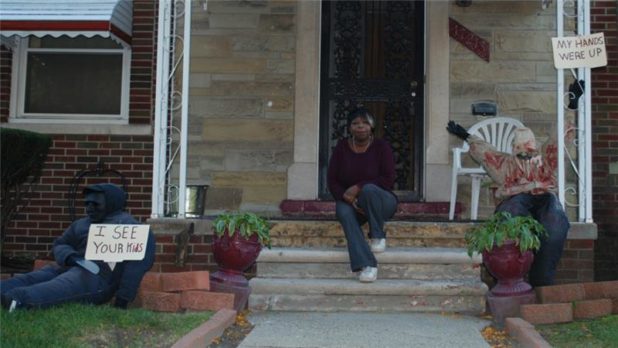Stuff Black People Don’t Like
October 23, 2016
Easily, one of the funniest articles you’ll ever read.
Once you understand 83 percent black Detroit is nothing more than Africa in America, you’ll get why this article represents the kind of black history the silly museum in Washington D.C. wants you to never, ever mention. [Grisly Halloween display in Detroit decries US violence: Grandmother replaces traditional decorations with real-life horrors in protest against violence and injustice., Al Jazeera, 10-20-16]:
Detroit, United States – At a home on the city’s west side, light-hearted Halloween decorations have been replaced with gruesome displays of murder, poisoning, kidnapping and attacks, all inspired by real-life events.
“Nothing make-believe about it,” said Larethia Haddon, the 56-year-old Detroit native behind the display. “This is going on every day in real life.”
The project is Haddon’s protest against the violence and racial injustice afflicting her country.
At her doorstep is a dummy stained blood-red with a sign that says “My hands were up”, referring to recent cases of police officers killing unarmed black men.
Below her window, a Frankenstein-like figure wields a fake knife and a sign that reads “I see your children”.
Representations of a book-bag bomb, victims of carjacking and the Flint water crisis, and a mother holding her dying children cover the lawn.
The chilling scene has the neighbourhood talking, and the message is spreading even outside the city’s border.
“It’s my little statement, and it seems to be working,” Haddon said.
The message hits close to home.
For years, Detroit has ranked consistently as one of the most violent cities in the country. A staggering 40-percent poverty rate and nearly 300 murders last year landed it the undesirable runner-up spot in a table of the most violent cities in America.
Less than an hour away, the people of Flint, Michigan, are entrenched in a battle for clean drinking water.
Since 2014, residents’ tap water has been contaminated with lead. The state government was slow to address the crisis and quick to deny responsibility for causing it.
“Everyone knows what’s going on in Flint right now. It’s a third-world country out there. No one should have to live like this,” Haddon said, pointing to her unique protest against the crisis. It is a dummy holding yellow water with a sign that reads “Flint water nobody deserves”.
Passers-by congregate around the display, snapping pictures and taking in the message. Every week, members of a nearby church encircle the dummies and hold hands, praying for an end to the violence.
“Stop killing black people. Stop the violence,” said Ashley Parker, 16, who wandered past the display one recent evening.
Shortly after, the driver of a beige Ford Taurus, one of several cars that slowed to a halt in front of the display, yelled out the window: “I love it. It’s wrong what they do out here.”
Haddon has lived in the city all her life. Neighbours address her as “Miss Haddon”, and she is quick to embrace strangers with an exuberant smile and a “Hello, child”. Behind her warm brown eyes, however, she is sick with worry for the future of her family.
A nearly full moon loomed in the darkening sky as Haddon explained that the inspirations behind the display are actually her grandchildren: Ciera, 14, DeAndre’, nine, and Kiera, five.
“My grandbaby Ciera says to me, ‘Grandma, there’s too many babies being killed,'” Haddon said, and they went to work on the scene of a mother holding her children.
“DeAndre’ asked me, ‘Why are all our fathers and brothers being killed? I don’t understand, Grandma,” Haddon said. The two then made the dummy representing police brutality and gun violence.Skeletons, spider’s webs and carved pumpkins are the more conventional choices of decorations ahead of Halloween, celebrated on October 31.
Although this is the first year Haddon has put up the full display, she said she has been decrying violence and injustice for 20 years by laying out a single dummy on her front lawn.
Last year, it caught the attention of police when people began calling 911, fearing the dummy was real.
She decided she needed to send a more concrete message with her protest. “I prayed on it, and said, ‘Lord, what can I do?'”
The resulting display was met with overwhelming support, Haddon said, including from police.
Michael Woody, director of media relations for the Detroit Police Department, said last year’s dummy caused alarm for some citizens, but there have been no such complaints this year.
“This is their freedom of speech, and we fully support that,” Woody said.
Still, Woody said, the best way to spark discussion about large issues such as gun violence is to talk with police officers and the community.
However eccentric, Haddon has found a way to make a statement, and most importantly, she said, get people to talk.
“We need to come together instead of sit back and watch things happen to people,” Haddon said. “We need to start helping each other change people’s minds.”
So in the hope of building a brighter, more peaceful future for her grandchildren, Haddon said she will continue to set up the display each morning and take it down again each evening. If left out overnight, she explained, thieves tend to steal her dummies.
“All I can do is just pray for those people.”
“Decrying” black on black violence for 20 years?
Of course, the best part is the complete lack of social capital in this city replete with virtually no trust among its less than seven percent white (93% non-white, 83% black) citizenry: Haddon can’t leave her display out at night or else – as she admits – black people would steal it.
Of course, Flint is considered a third world city precisely because it has a third world population (same as Detroit).
America, this is a glimpse of your future if nothing changes: black people putting out overtly anti-white displays and then taking them down at night so fellow black people don’t steal them.
 Daily Stormer The Most Censored Publication in History
Daily Stormer The Most Censored Publication in History



